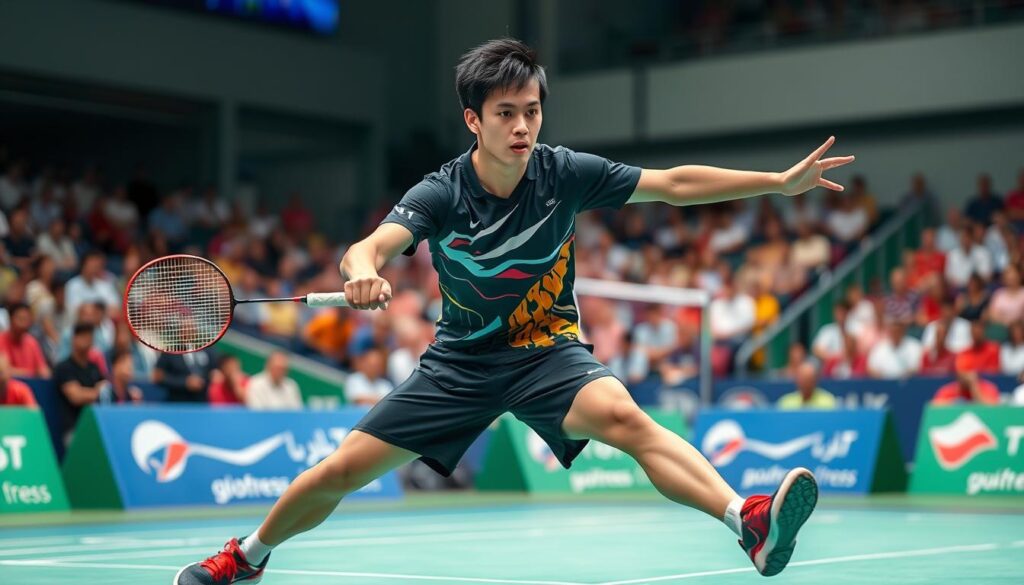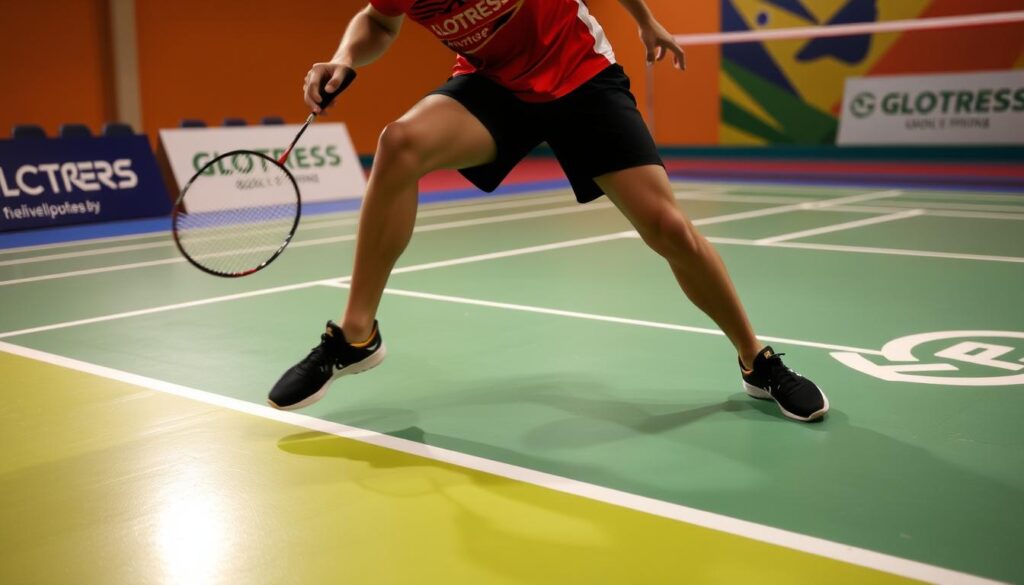Your footwork is key in badminton. Learning the right footwork can make you a better player. This guide will cover the basics of footwork, like split steps and lunging, to improve your speed and control.
Good footwork is essential for quick movements and strong shots. Mastering footwork will improve your performance and impress your opponents.
Technique for Badminton Footwork The Key to Success
Success in badminton requires precise footwork, which is essential for players. We’ll examine the importance of proper footwork and the components of a potent technique.
Correct Footwork Is Crucial in Badminton
Because badminton moves quickly, players must be agile and effective. You can precisely hit your own shots and respond to shots thanks to your footwork. Your game will suffer if you can’t move smoothly.
Essential Components of Skillful Footwork
Good badminton footwork involves mastering several key elements:
- Balance and Stability – A solid stance is key for power, quick changes, and fast recovery.
- Weight Transfer – Smoothly moving weight helps in explosive movements and shuttle control.
- Court Positioning – Knowing your court position and the shuttle’s path helps anticipate and react.
- Coordination and Agility – Quick, agile footwork is needed for covering the court and precise shots.
Focusing on these elements can improve your court movement and shot execution, which leads to better court success.
Split-Step: The Starting Point for Explosive Movement
The split step is essential in badminton’s fast-paced environment. It serves as the foundation for swift motions and quick responses. This technique helps you guess your opponent’s shots and respond quickly.
The split step is a simple yet powerful move. It involves standing with your feet apart, keeping a low stance. This stance lets you move easily in any direction, whether chasing a deep shot or rushing to the net.
Learning the split step is the first step in improving your agility training and court movement. Mastering this basic technique will allow you to react faster, preparing you for strong shots and solid defense.
- Adopt a balanced, low stance with your feet shoulder-width apart.
- Shift your weight slightly forward, ready to propel yourself in any direction.
- Keep your center of gravity low and your knees bent to improve your stability and explosiveness.
- Pay careful attention to your opponent and anticipate their next move.
The split step is the starting point for your court movement mastery. By adding this technique to your badminton skills, you’ll outmaneuver opponents. This sets the stage for a winning game.

“The split-step is the foundation for explosive movement on the badminton court. Nail this technique, and you’ll unlock a new level of agility and responsiveness.”
Mastering the Recovery Step
In the fast-paced world of badminton, the recovery step is key. It’s what makes a player go from amateur to pro. This move helps you get back in balance and ready for your next shot or quick move on the court. Learning the recovery step opens up new ways to control the game.
Regaining Balance and Positioning
After hitting a shot, you need to get back to center quickly. The recovery step is a small, fast move back or to the side. It helps you stay stable and move smoothly into your next spot.
Good balance is the base of a great recovery. Add balance exercises to your training. Single-leg stands, lunges, and plyometric drills boost your control and prepare you for the game’s challenges.
Efficient Recovery for Quick Transitions
A good recovery step should be quick and precise. Don’t waste time or slow down; this makes you easy to catch. Aim for a fast, accurate step to return to the game quickly.
Smooth court movement is crucial in badminton. The recovery step connects each shot to the next. You’ll move smoothly around the court by mastering it, ready to react and play confidently.
“The recovery step is the foundation of explosive movement in badminton. Master it, and you’ll unlock a new level of agility and court control.”
Lunging Techniques for Offensive and Defensive Play
Mastering the lunge is key in badminton, both for offense and defense. This section will cover forehand and backhand lunges, as well as controlling shot depth and power.
Forehand and Backhand Lunges
The lunge is a basic move in badminton. It lets you reach further and cover more ground. For a forehand lunge, push off your back leg and stay low. For a backhand, rotate your hips and shoulders for more power.
- Stay balanced and stable during the lunge
- Keep your eyes on the shuttlecock and your racket up
- Avoid lunging too far, which can make you lose your balance
Controlling Depth and Power
Controlling shot depth and power is vital. To control depth, think about your opponent’s shot distance and angle. Then, adjust your lunge. Use your legs and hips to keep your upper body relaxed for more power.
| Technique | Benefits |
|---|---|
| Forehand Lunge | Increased reach and coverage on the court |
| Backhand Lunge | Powerful shots with more rotational force |
| Depth Control | Ability to respond effectively to different court positions |
| Power Generation | Stronger, more explosive shots to put pressure on your opponent |
Mastering the lunge is essential for a well-rounded badminton player. Focus on proper technique and shot control. This will help you dominate on the court.
Pivoting: A Game-Changer on the Court
In badminton, quick changes in direction are key. Pivoting is a game-changing skill that can boost your performance. It’s all about moving fast and responding to shots.
Good pivoting means keeping balance and control. It lets you move smoothly and set up for your next shot, giving you an edge over your opponents.
Mastering the Pivot Technique
To pivot well, focus on these key points:
- Footwork Precision: Start by planting your lead foot firmly. This stable base lets you rotate smoothly.
- Knee Flexion: Keep your knees slightly bent. This stance helps you control your pivot.
- Upper Body Rotation: Turn your shoulders and upper body first. Keep your eyes on the shuttle for a smooth move.
Practice is key to mastering pivoting. Add pivoting drills to your training, and focus on court movement and balance exercises to improve.

“Pivoting is the cornerstone of agile court movement in badminton. Mastering this technique will elevate your game to new heights.” – Coach Sarah Johnson
Embracing pivoting unlocks new levels of control and speed. This technique can take your game to new heights.
Weight Transfer and Balance Exercises
Mastering badminton footwork starts with weight transfer and balance. These abilities enable you to move quickly, change course, and maintain control. We’ll examine workouts and methods to improve your core strength, agility, and stability, which are key to precise and powerful footwork in badminton.
Improving Stability and Agility
Stability and agility are vital for good badminton footwork. Balance exercises can improve your quick weight shifts and direction changes. Here are some drills to try:
- For single-leg balance exercises, raise one leg while standing and hold it there for at least thirty seconds. Then, switch sides.
- Lateral side steps: Quickly shift your weight side to side while taking tiny steps using cones or markers.
- Drills, including an agility ladder: As you climb the ladder, practice different stepping patterns to improve your speed and coordination.
Strengthening Core Muscles for Better Control
A robust core is necessary for balance and effective weight transfer in badminton. It encourages stability and control over the body. Try these exercises to improve your core:
- Planks: For 30 to 60 seconds, maintain a straight back and a tight core.
- You sit on the floor and alternatively move your upper body in different ways in this Russian twist.
- Bird dogs: On all fours, extend one arm and the opposite leg, keeping balance.
Maintaining consistency and commitment to these workouts will improve your control, agility, and stability. To become proficient in badminton footwork, you must do this.
How to Get Better at Badminton Footwork
If you want to be a great badminton player, you need to improve your footwork. We made games to help you move around the court faster and better.
Ladder Drills for Footspeed and Coordination
Ladder drills are great for bettering your footwork. They test your agility, speed, and coordination as you move through the ladder’s steps. Quick, precise footwork helps you react fast and play better badminton.
- Forward Ladder Drill: Step quickly through the rungs, keeping a smooth pace.
- Lateral Ladder Drill: Move side to side, placing your feet in each rung.
- Zig-Zag Ladder Drill: Zigzag through the rungs, changing direction with each step.
Shadow Drills for Movement Patterns
Shadow drills help you improve your movement and footwork. By copying your coach or a skilled player, you learn to react to different situations. This builds muscle memory and positioning for quick moves and recoveries.
- Backhand to Forehand Shadow Drill: Work on your footwork and where you stand for both forehand and backhand hits.
- Defensive Shadow Drill: Work on quick side-to-side steps and recoveries to cross the court.
- When attacking with Shadow Drill, focus on lunges and pivots that explode for strong offensive shots.
Adding these footwork drills, ladder drills, and shadow drills to your training will boost your footspeed and coordination, helping you excel in badminton.
Agility Training for Badminton Players
It’s important to be quick on your feet in badminton so you can react to hits and prepare for returns. Plyometric exercises and speed drills will help you move around better, which could change how you play.
Incorporating Plyometrics and Speed Drills
Plyometric exercises like box jumps and hurdle hops improve explosive power and dynamic movement. These routines work on fast-twitch muscles for quick changes in speed and direction. Adding speed drills like shuttle runs and agility ladder drills can help you move and react faster.
With these exercises, you’ll see better court coverage and shot returns. Your responsiveness to opponents will also improve. Your badminton skills will improve with regular practice, giving you an advantage on the court.

